2019 Field Pea on grey soil, Calavos
Grower: Tony Chapman, Chapman Ag. Tony has been growing field pea for many years and has needed to learn-on-the-job as field pea varieties are not often grown so far north or in coastal environments.
Location: Calavos, Bundaberg
Monitored area: 20 ha, grey soil, irrigated
Crop rotation: Cane harvested October 2018, soybean harvested early May 2019. This crop of field peas will be grown with the intention to harvest grain. The growing season is approximately 12-14 weeks long.
Maki is a northern field pea variety more commonly grown on the Darling Downs and Northern NSW, north of the Macquarie Valley. Tony uses field pea to improve soil fertility and to fill the gap in the rotation over winter. Cane will be planted immediately after the field pea crop is harvested.
Maki is a green-seeded blue pea that is suitable for human consumption or stock feed. It has very low levels of Trypsin Inhibitor Activity, which is a significant anti-nutritional factor for livestock. The variety produces grain with a low hard seed count and shows good resistance to seed bleaching.
Week 1
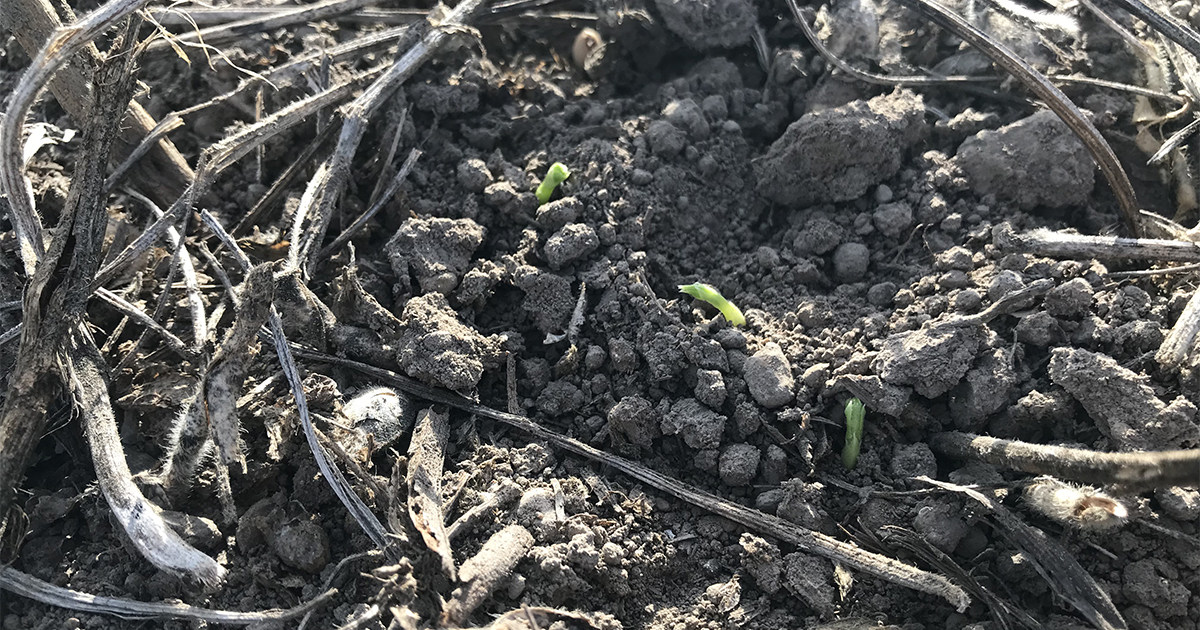 Maki field pea seedlings emerging just a week after planting.
Maki field pea seedlings emerging just a week after planting.
Management notes:
- Maki field peas planted on Wednesday 22 and Thursday 23 May.
- Planting rate of 450,000 seeds/ha to achieve establishment rate of 400,000 plants/ha.
- Seed inoculated with field pea peat inoculant (Group E) using water injection method at seeding [1 kg bag peat per 500 kg of seed].
- Seed was direct drilled into soybean stubble with 4 rows per bed (rows 280 mm apart), with controlled traffic spacings of 1.83 m.
- A recommended fertiliser blend was band applied at planting at 160 kg/ha.
- The block was sprayed with paraquat non-selective herbicide and a wetter post-plant pre-emergence of the crop, on the 26 May to control any volunteer soybeans and other weeds.
- There is enough moisture in the soil for germination, however the crop will be irrigated when necessary.
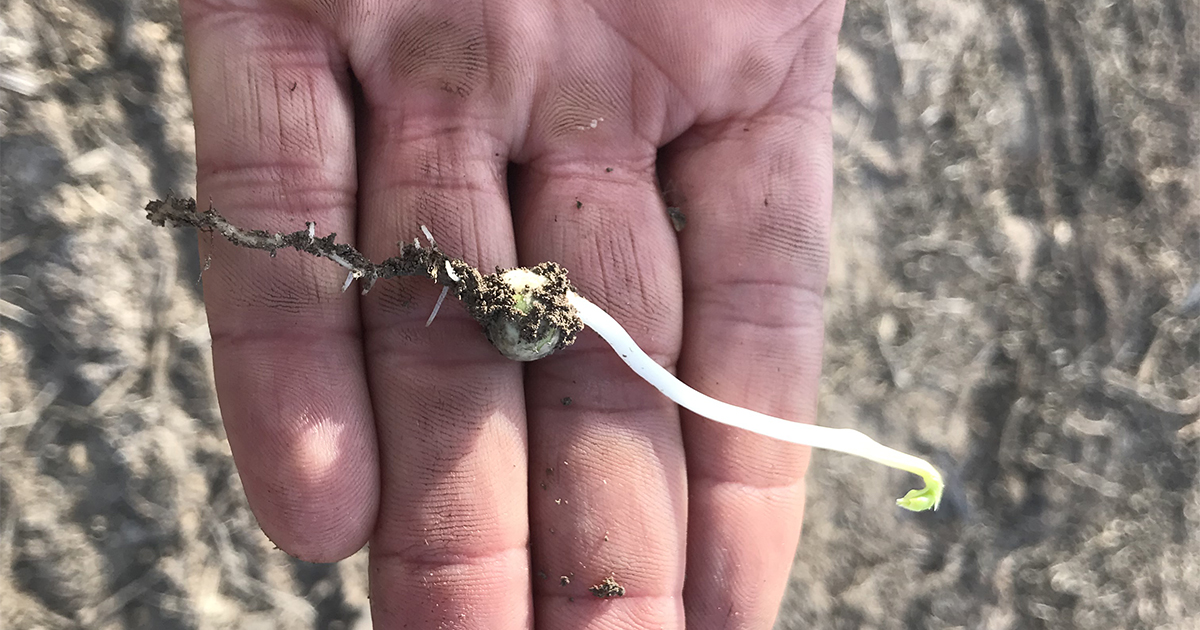 Emerging field pea seedlings are quite a vigorous as their cotyledons remain underground (hypogeal emergence) and do not need to be pushed to the surface (e.g. mungbean – epigeal emergence).
Emerging field pea seedlings are quite a vigorous as their cotyledons remain underground (hypogeal emergence) and do not need to be pushed to the surface (e.g. mungbean – epigeal emergence).
Week 2
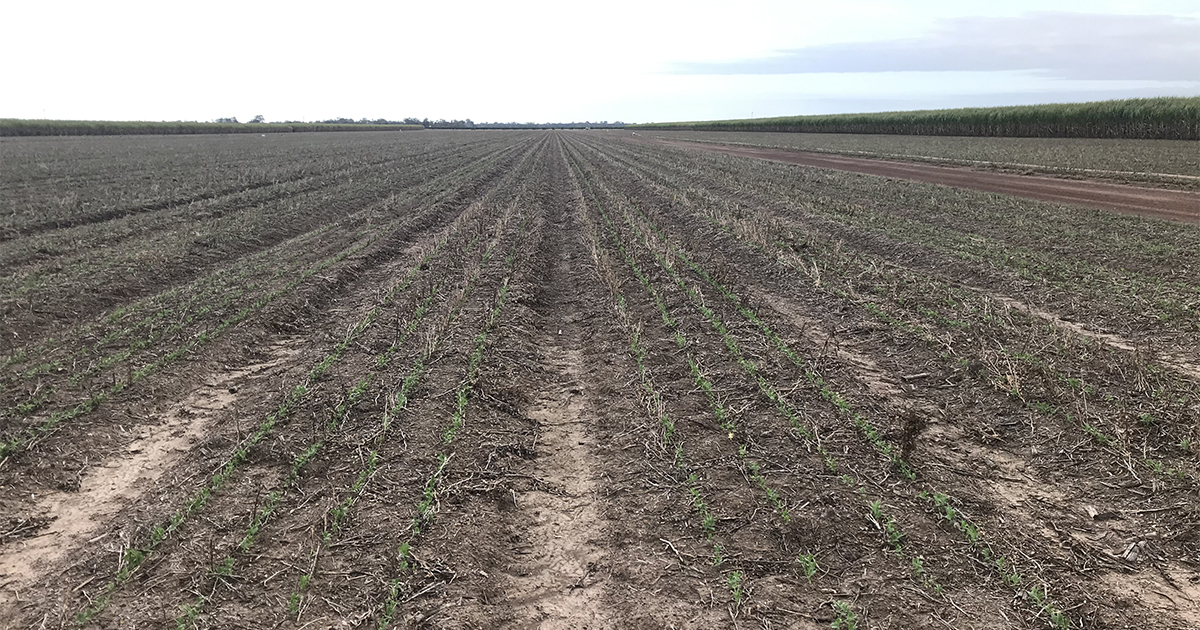
Management notes:
- The field peas have emerged this week through the existing soybean stubble.
- 18-20mm of rainfall was recorded on Monday, which boosted germination.
- Irrigation had started and 50% of the block was covered before the rainfall event.
- A nutrient spray of sodium molybdate, zinc and molasses is planned within the next few weeks.
- On the lookout for any vine weeds and if necessary an MCPA herbicide will be applied when the peas are at the 4 true leaves stage.
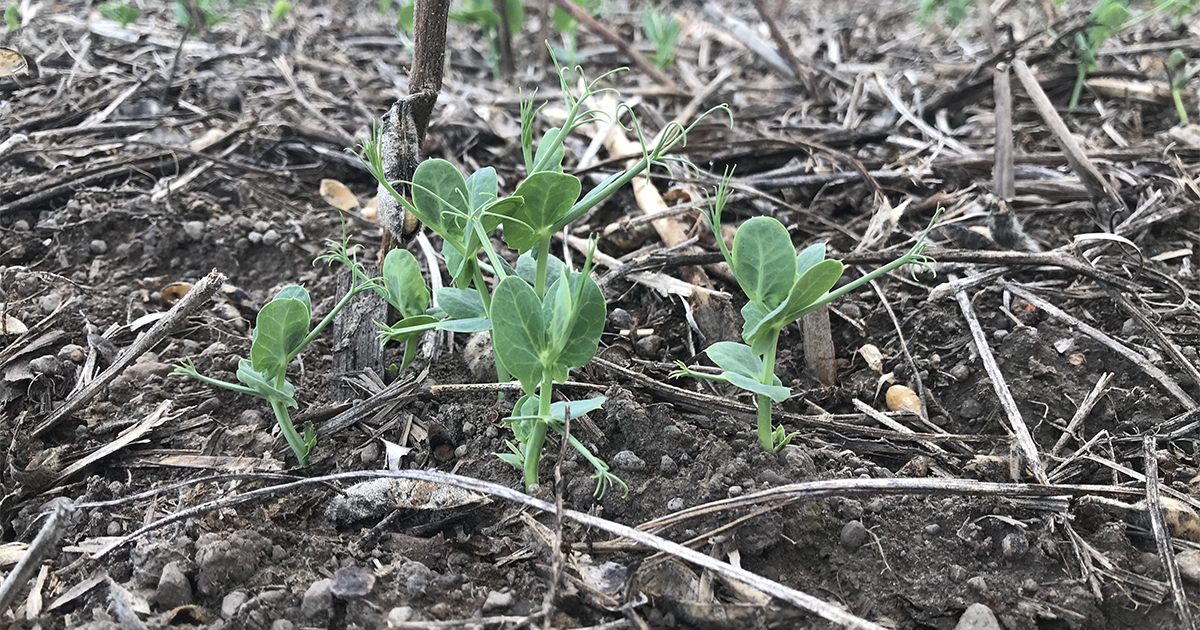 Field pea seedlings making the most of rain and irrigation this week.
Field pea seedlings making the most of rain and irrigation this week.
Week 3
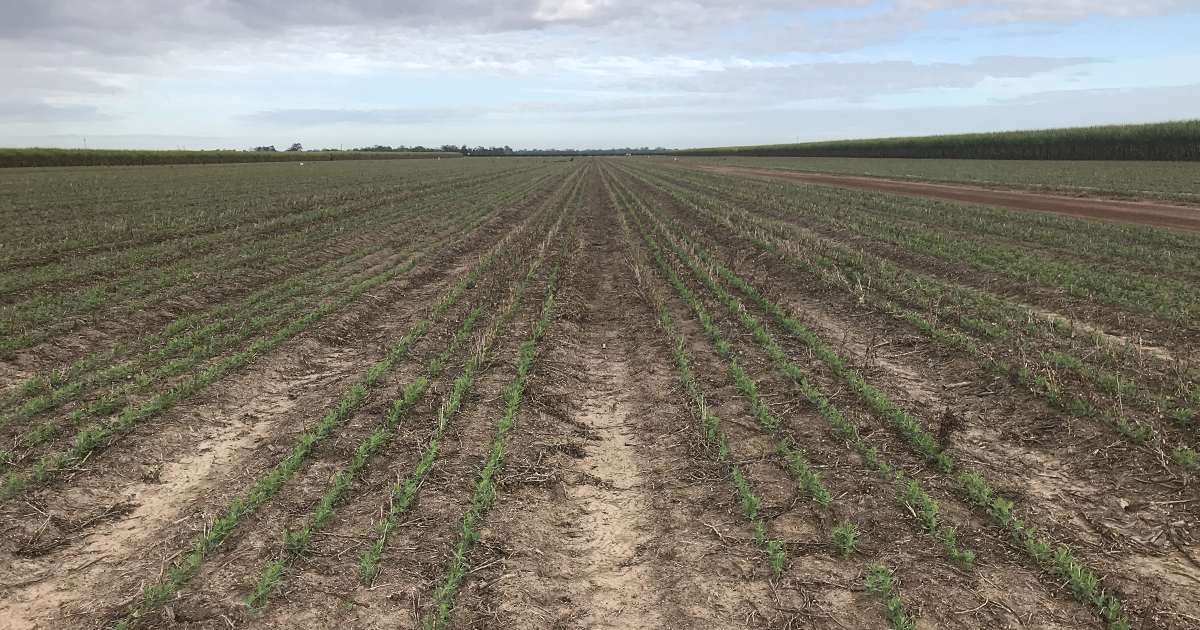
Management notes:
- Plants are growing well with a mostly uniform germination. A small number of plants are late germinating.
- Small percentage of germinating soybeans in the paddock but seem to be sick as a result of prior herbicide application.
- This week trace elements such as sodium molybdate, zinc, molasses and urea will be applied.
- A possible herbicide application to control convolvulus and germinating soybeans may be scheduled in the coming weeks.
- Monitoring soil moisture to schedule the next watering.
- Some damage to a few emerging seedlings where the plant has been cut off from the root under the soil. Possibly a cut worm issue but any other advice on the issue is welcome.
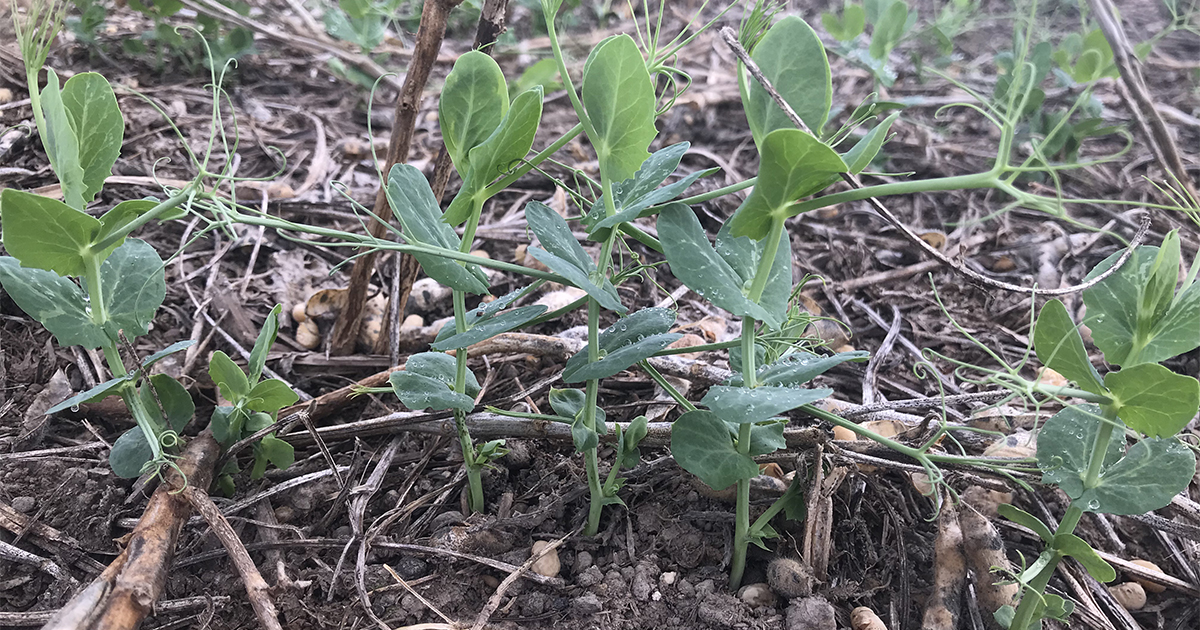 Strong emergence and growth.
Strong emergence and growth.
Week 4
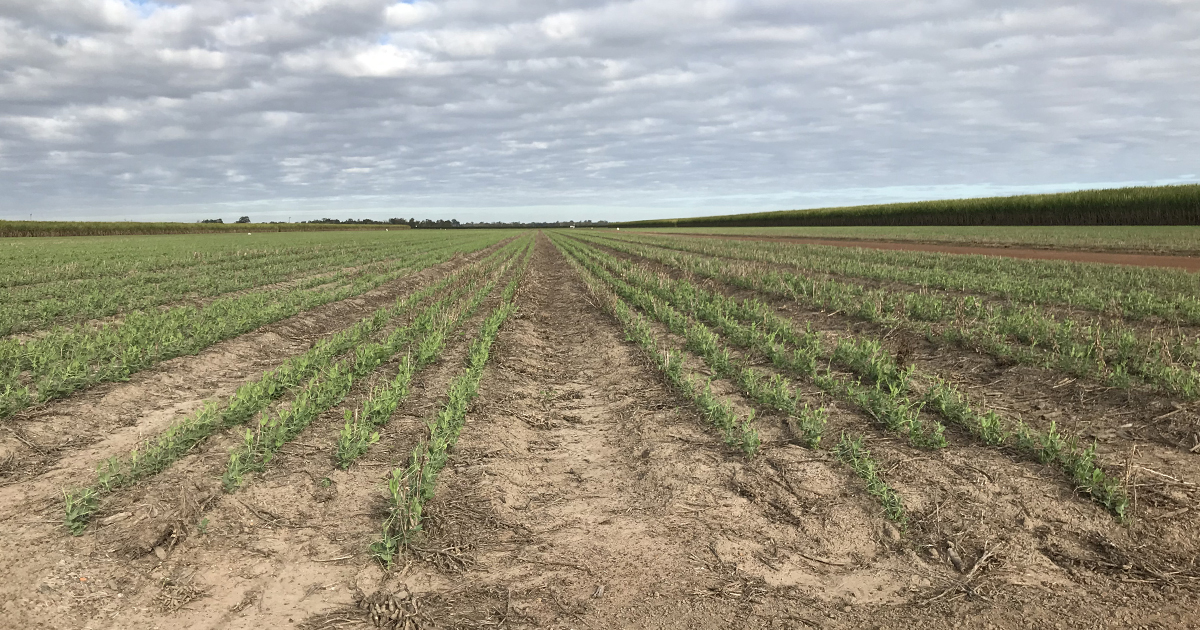
Management notes:
- Plants are green and look healthy. No symptoms of stress at this stage.
- No irrigations have been made since the last rainfall event.
- Most plants are between 4 and 5 leaf stage and received their trace element spray of sodium molybdate, zinc, urea and molasses this week.
- Plants that are close to water puddles from leaking irrigation have been chewed by ducks that have been hanging out in the water.
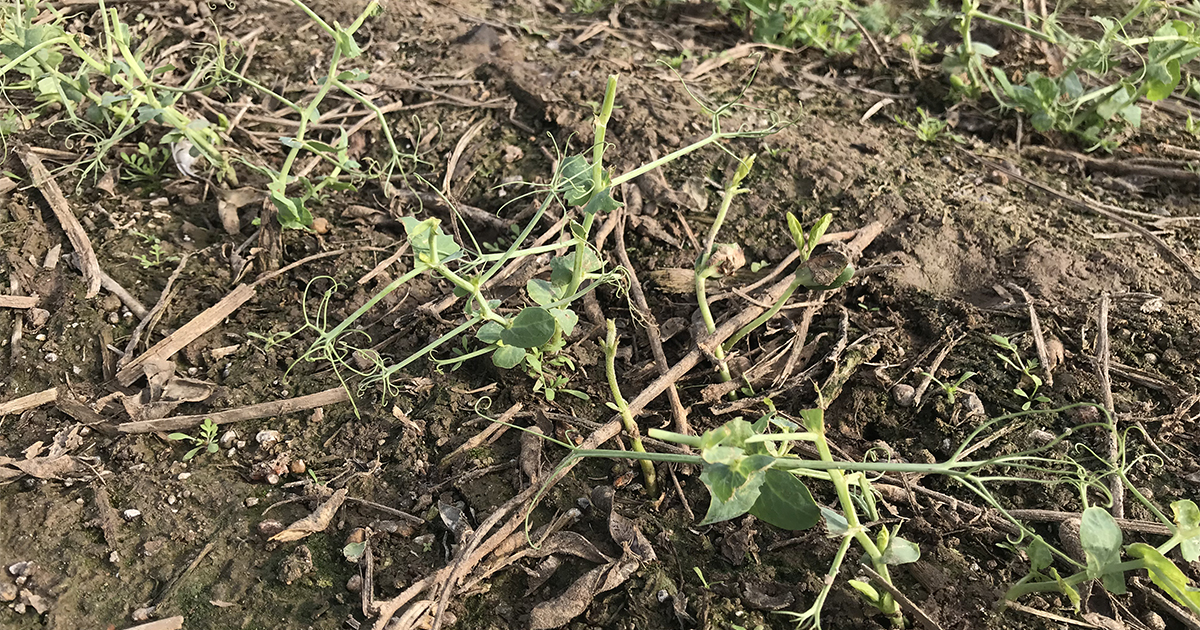 Patches near water puddles have been defoliated by ducks.
Patches near water puddles have been defoliated by ducks.
Week 5
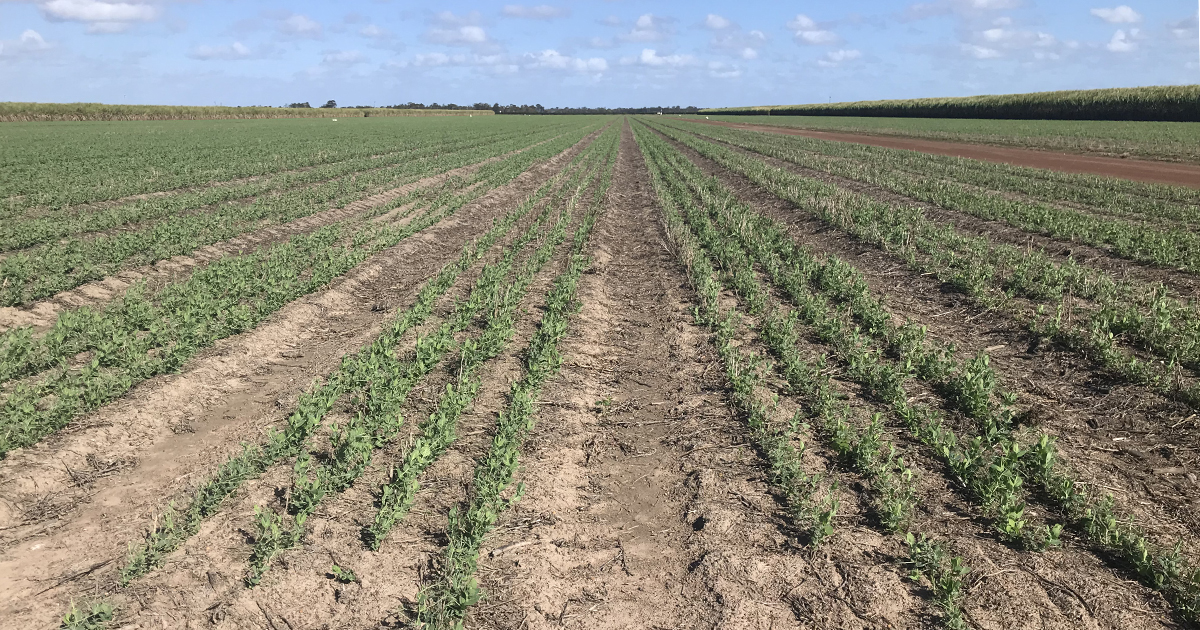 Management notes:
Management notes:
- Plants are green and healthy, not showing any signs of stress.
- This week there has been 7 mm rainfall. An irrigation is scheduled for the coming week.
- Another trace element spray with molasses is also planned for the near future.
- Ducks are continuing to be a problem in the crop, particularly where there is water laying nearby.
- A very small number of aphids were observed on the developing leaves close to the soil. The population observed does not warrant any action.
- A few plants in patches have been observed being cut off below ground level. The causal agent was not identified when digging in the soil in an affected area.
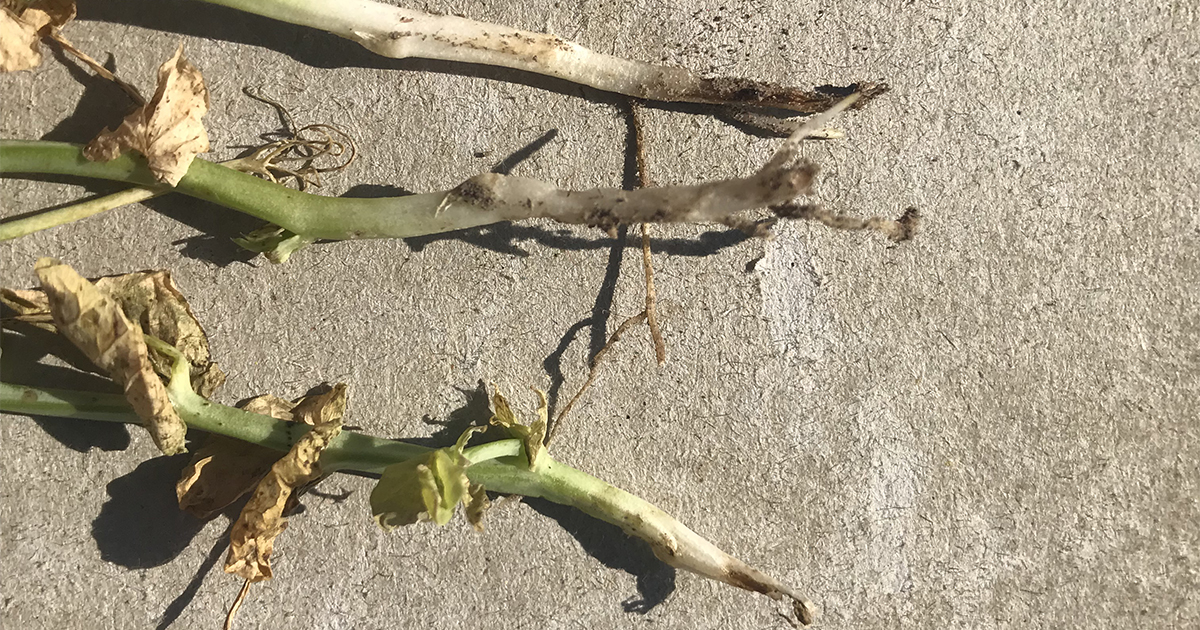 The cause of this chewing damage to some seedlings remains a mystery. Do you recognise this damage?
The cause of this chewing damage to some seedlings remains a mystery. Do you recognise this damage?
Week 6
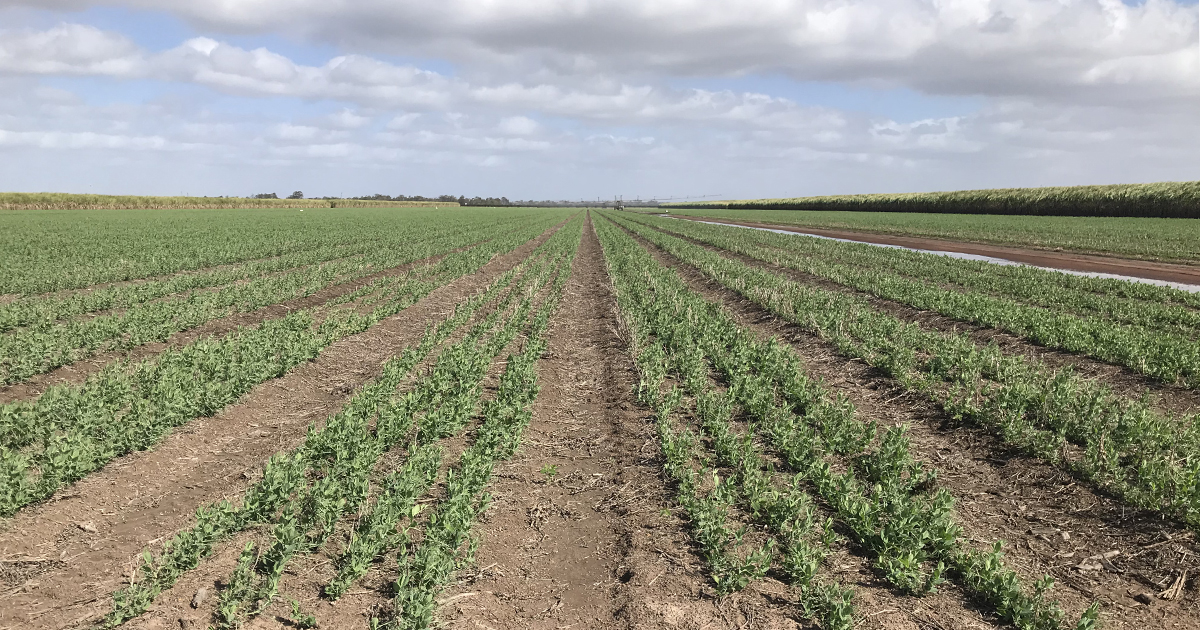
Management notes:
- The field peas were irrigated over the last week with the last block completed on Friday.
- A trace element and molasses mix was applied to the peas last week with no further plans for the coming week regarding nutrition, water or herbicide application.
- Small patches are being monitored where plants are being ‘cut-off’ just under the soil surface.
- Causal agent still has not been dug up; however, it is quite possibly white-fringed weevil larvae.
- This pest occurred at the Chapman's farm a few years ago resulting in similar damage in a block of field peas following a soybean crop, which is the same scenario occurring now.
- The block which had peanuts in it before field peas seems to be less affected (if at all) at this stage with very few bare patches observed.
- Will continue to look for the pest species over the coming week to hopefully report back with a confirmed causal agent!
- Interesting to note that all the Chapman's common rotation crops (sugarcane, soybeans, peanuts and field peas) can be hosts to this pest.
- Here's a Beatsheet article about the previous infestation of white-fringed weevil larvae in Bundaberg field peas.
Healthy field pea plants compared to small areas of under-ground chewing damage and above-ground duck foraging.
Week 7
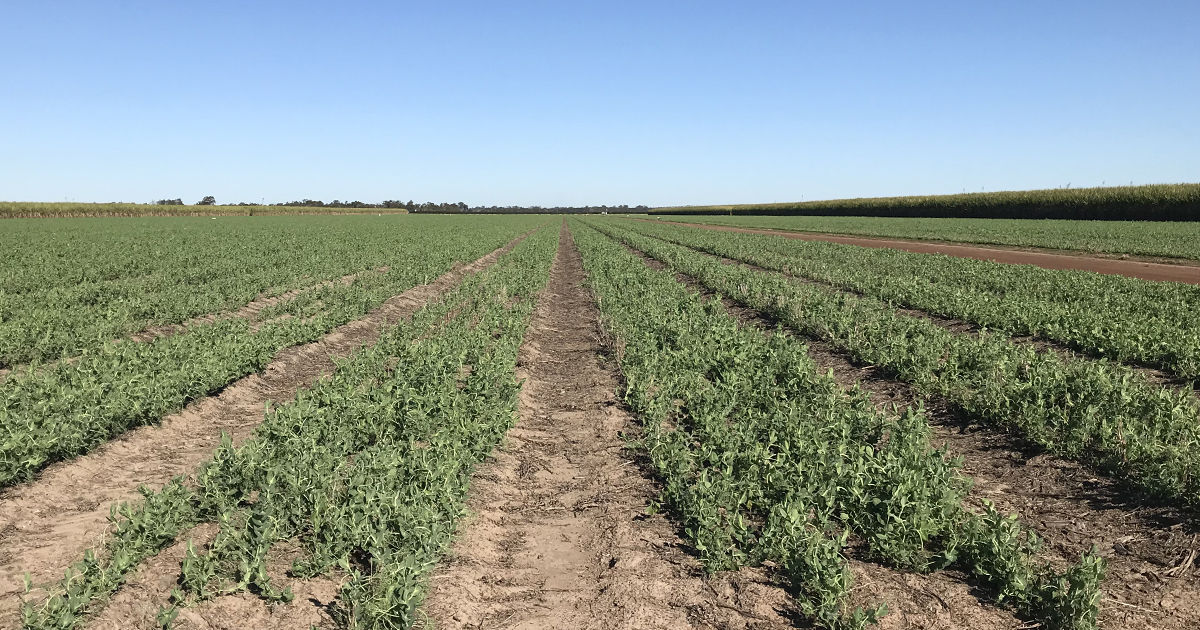
Management notes:
- About 5 mm of rainfall was received in last week's forecast rainfall event so irrigation will again begin this week for all blocks.
- Milk thistle, cobblers peg and emerging soybean plants require control.
- After more digging the seedling-killing culprit has been found! See the picture of the suspected white-fringed weevil larvae below. We are fairly confident that this is our pest as he was found trying to cut off a large seedling and several dead ones were nearby.
- There are also some millipedes found – fun fact, they have 2 pairs of legs per segment and are often found in leaf litter or eating decaying plant matter, so numbers can increase in zero-til, stubble retention systems. Millipedes are generally not associated with pulse crop damage as they primarily feed on decaying plant matter, a food source that is softer and lower in deterrent plant chemicals compared to living plants.
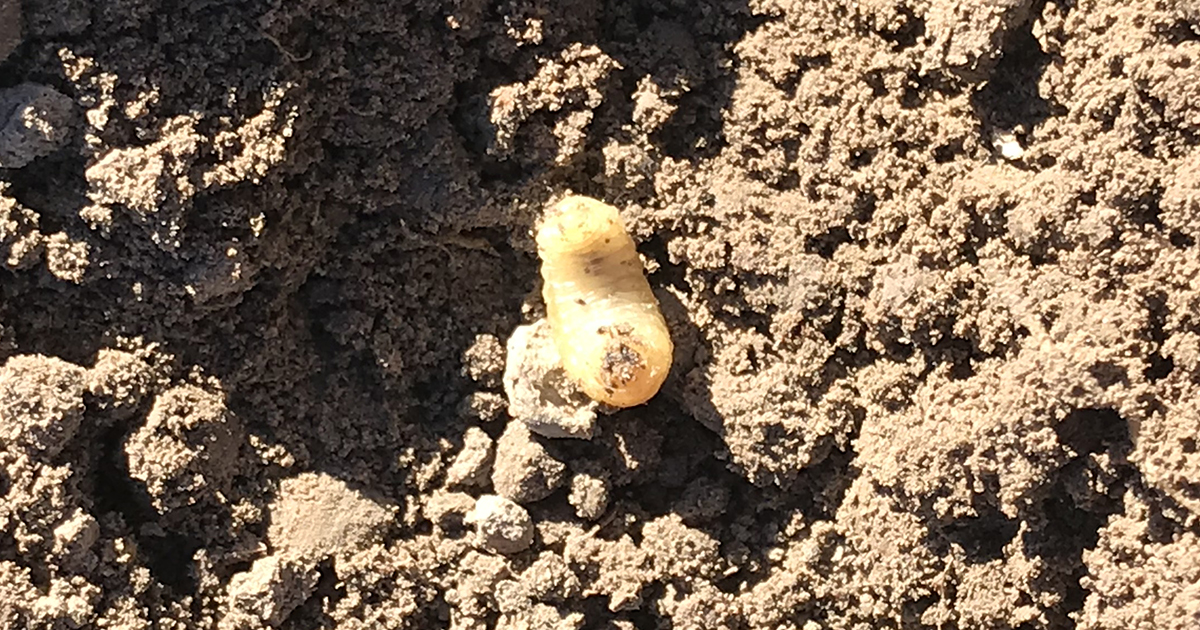 White-fringed weevil larvae.
White-fringed weevil larvae.
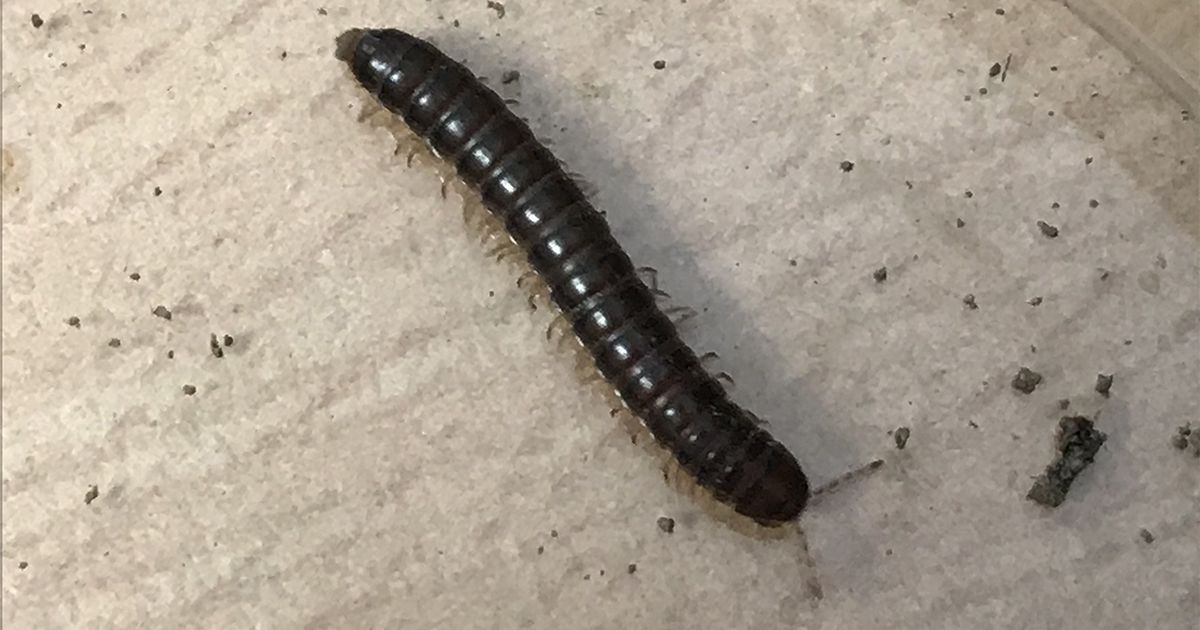 Millipedes often increase in numbers in high crop residue soils but they feed primarily on dead plant material.
Millipedes often increase in numbers in high crop residue soils but they feed primarily on dead plant material.
Week 8
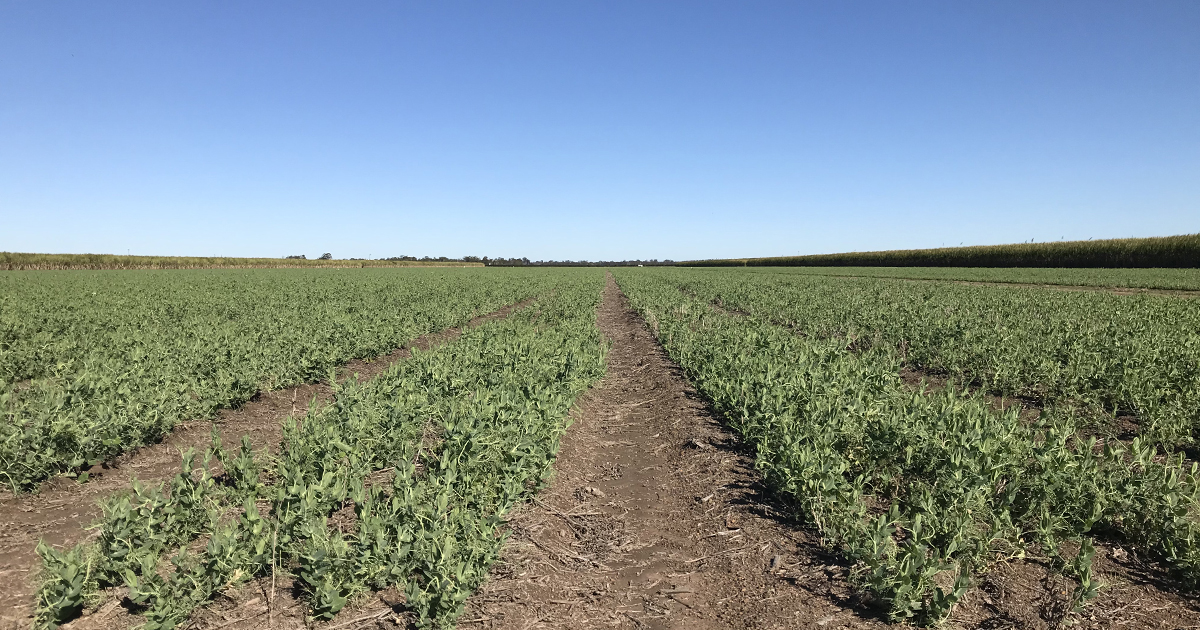
Management notes:
- The field peas are currently being irrigated with the monitored block the next on the list.
- The plants are looking green and healthy with vigorous growth. There are still patches of dead plants due to our weevil larvae.
- A few plants have begun flowering. These are most likely seed from another variety that has come with the planting seed.
- We will be keeping an eye out for any significant pest species now, such as heliothis, to avoid severe damage or losses to developing pods.
- Aside from the weevil larvae found last week there were no notable pest or disease issues seen this week.
- One last application of trace elements and molasses will be put on in the coming weeks to keep the field peas powering on.
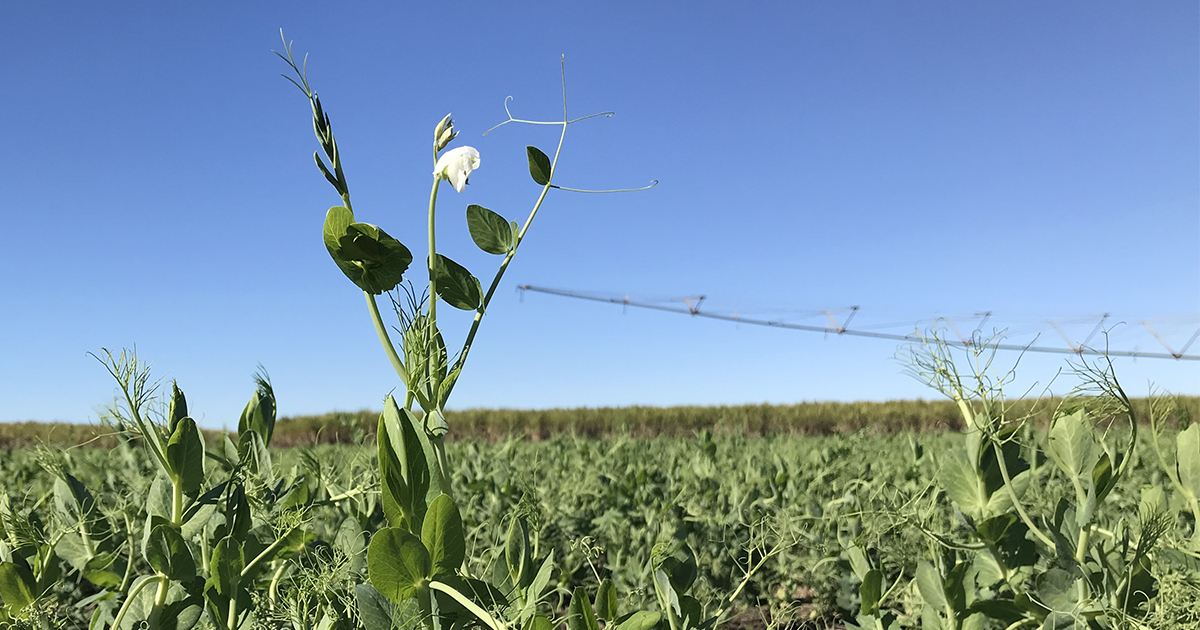 These early flowers might be on plants other than Maki variety, but they are a sign that flowering is not far off and insect scouting is going to be critical in coming weeks.
These early flowers might be on plants other than Maki variety, but they are a sign that flowering is not far off and insect scouting is going to be critical in coming weeks.
Week 9
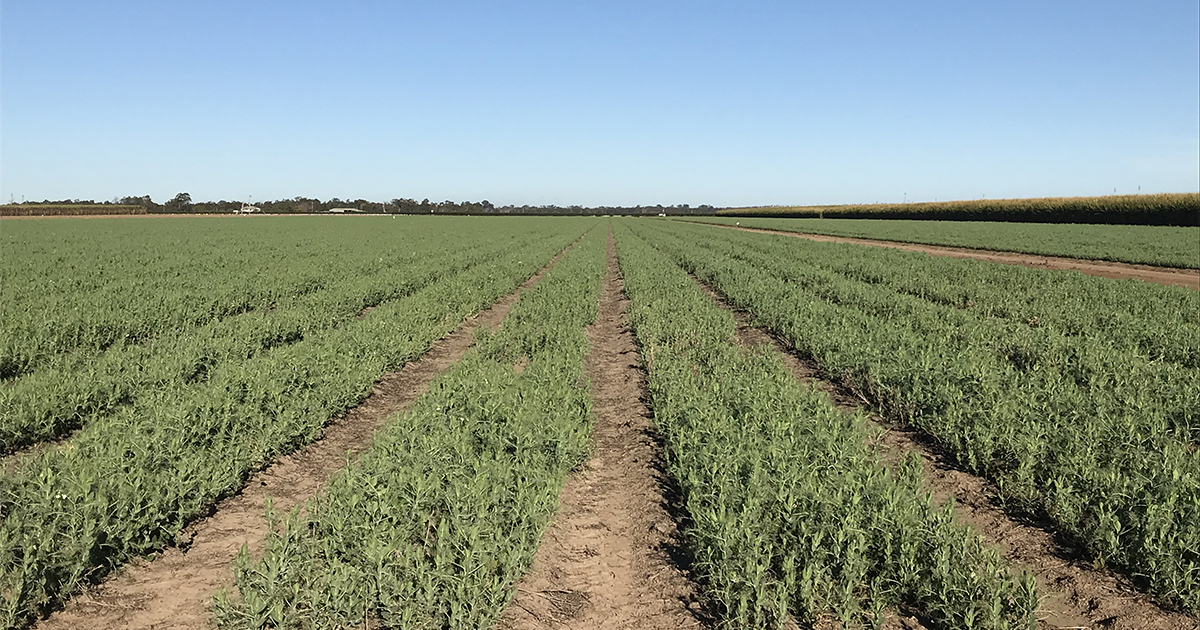
- Plants are green and healthy and have had their last trace elements and molasses spray during the last week.
- There are many flower buds developing with a small proportion of these slowly opening.
- In patches there is some minor leaf damage as a result of heliothis entering the crop. They were hiding out in the developing flower buds so monitoring these will be key over the next 2 weeks.
- An irrigation for this block is almost due however there will be some delay due to pump issues.
- Monitoring heliothis is the focus for the coming week so that a Vivus Max spray can be applied at the correct time.
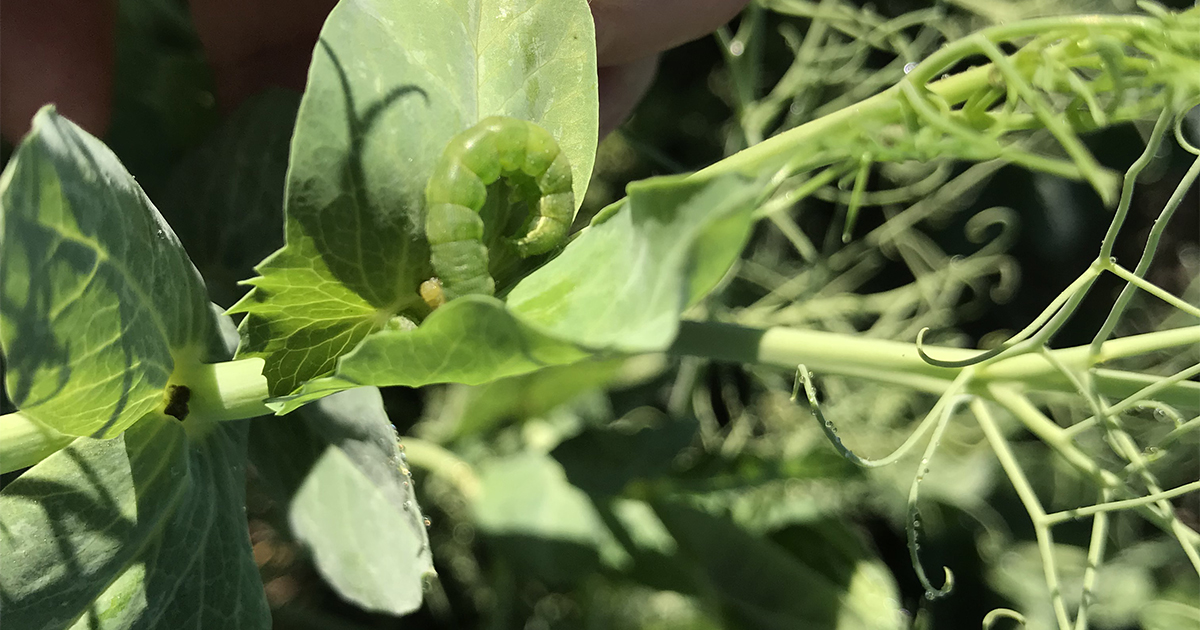 Heliothus larvae are starting to appear in the crop.
Heliothus larvae are starting to appear in the crop.
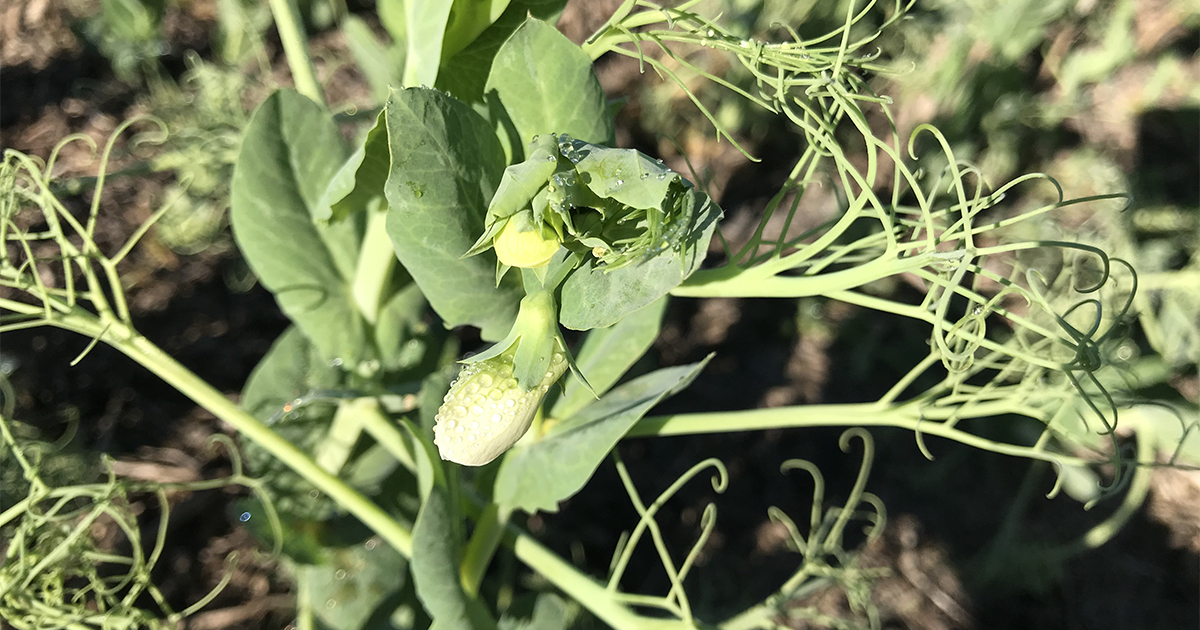 Maki field peas have a white flowers and will produce a green-seeded blue pea.
Maki field peas have a white flowers and will produce a green-seeded blue pea.
Week 10
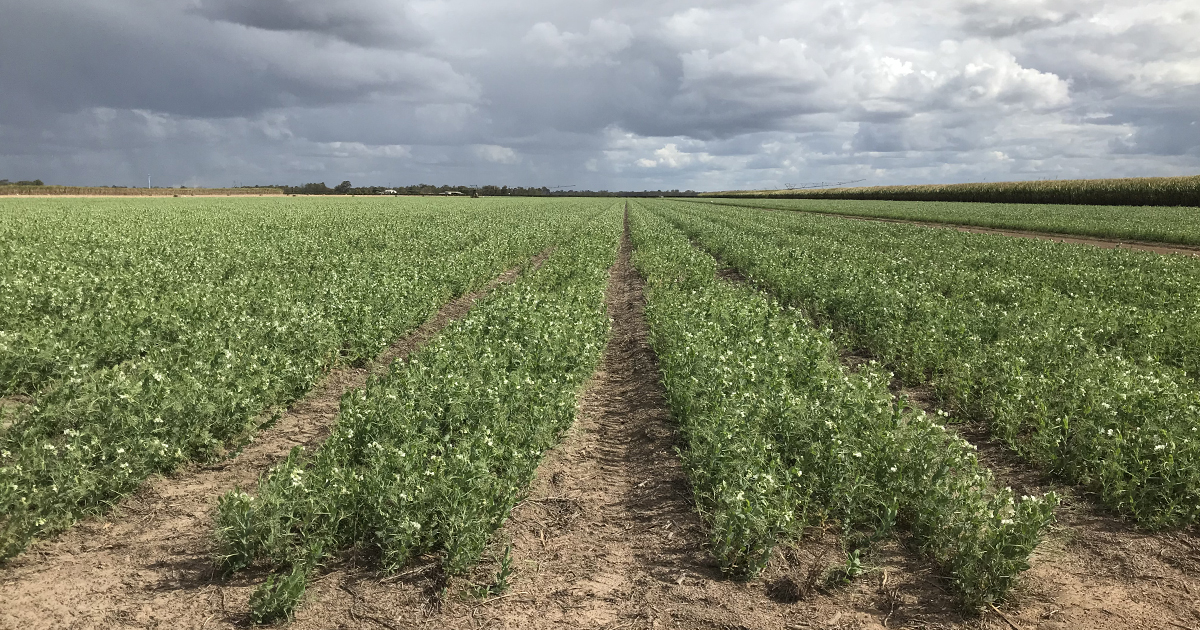
Management notes:
- Flowering is in full swing with many more buds almost ready to open.
- Irrigation has been underway over the last week with very little rain around or on the horizon.
- A few bees were spotted out feeding. Field peas are, for the most part, self-pollinating hence pollinators are not required. Some cross-pollination will occur but is not critical for pea development.
- Hot spots of heliothis caterpillars are appearing in the crop and Tony will be looking at applying a Vivus Max this coming week to protect the developing pods.
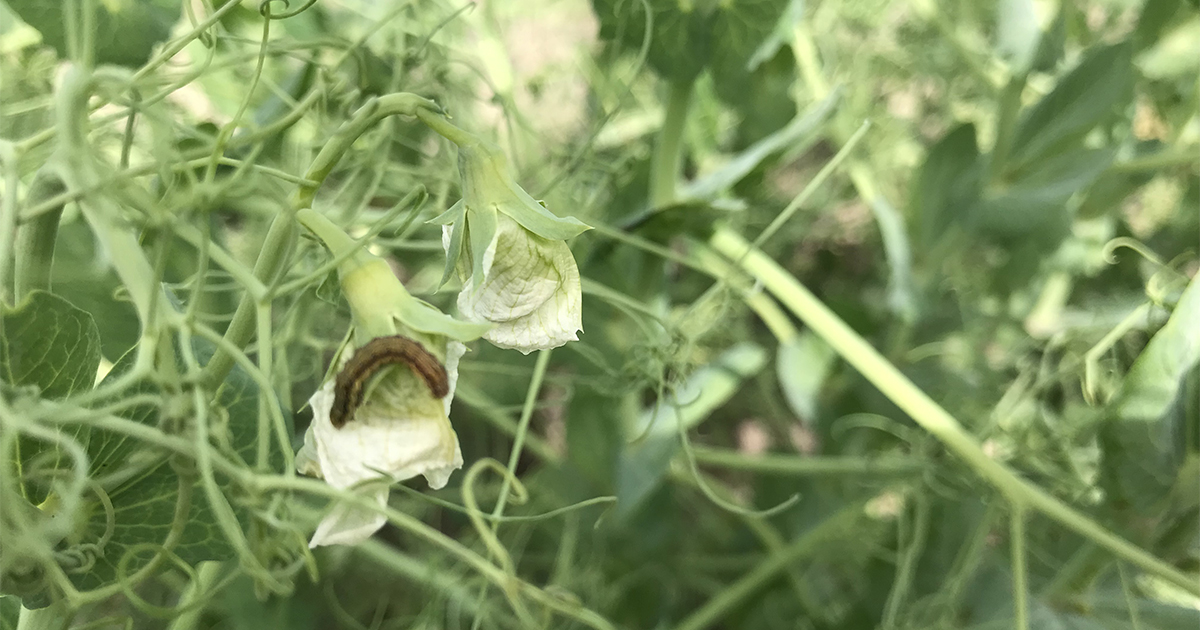 Heliothis caterpillars are starting to appear in hot spots, attacking flowers and buds.
Heliothis caterpillars are starting to appear in hot spots, attacking flowers and buds.
Week 11
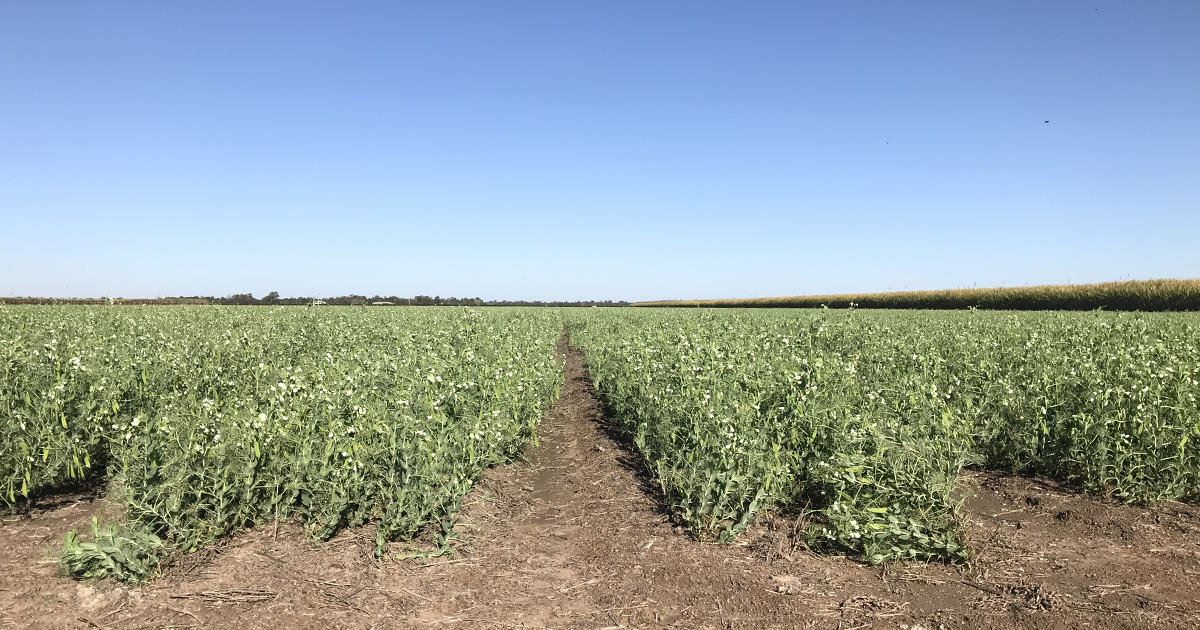
Management notes:
- The field peas are looking good and are developing pods in large numbers.
- 4 mm of rain was received this week, as well as an irrigation completed last week, giving adequate soil moisture for pod filling.
- A moderate population of heliothis is present and some pod damage has been observed.
- A Vivus Max application will be applied in the next day or so to control the heliothis population and reduce the risk of further pod damage.
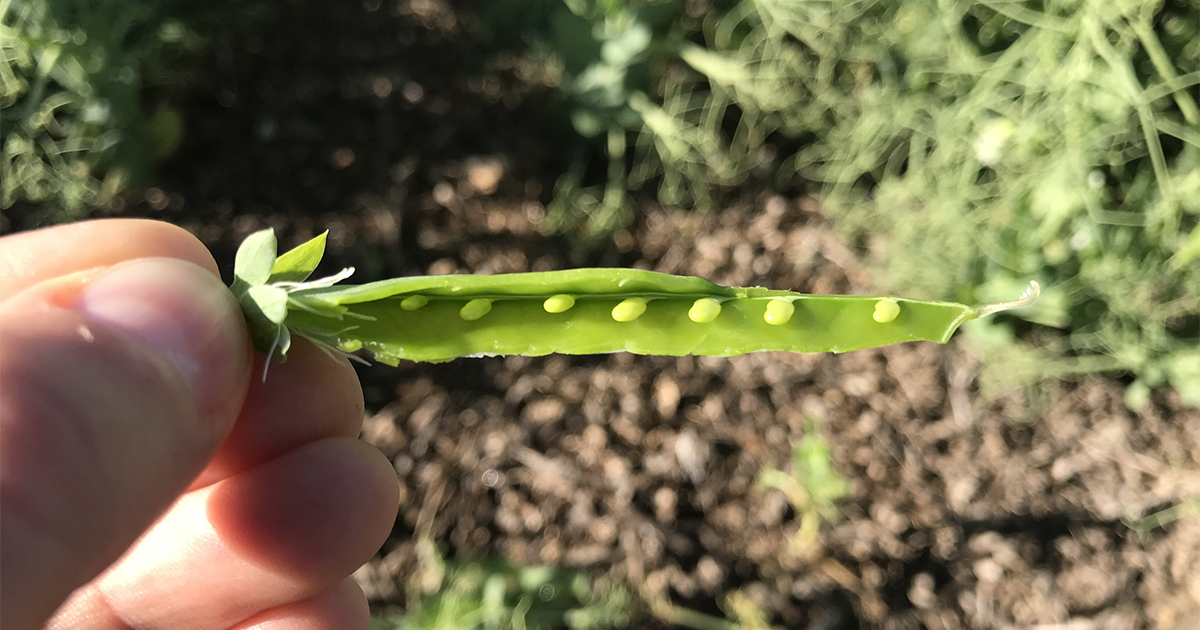 Peas are forming in the pods very quickly after flowering.
Peas are forming in the pods very quickly after flowering.
Week 12
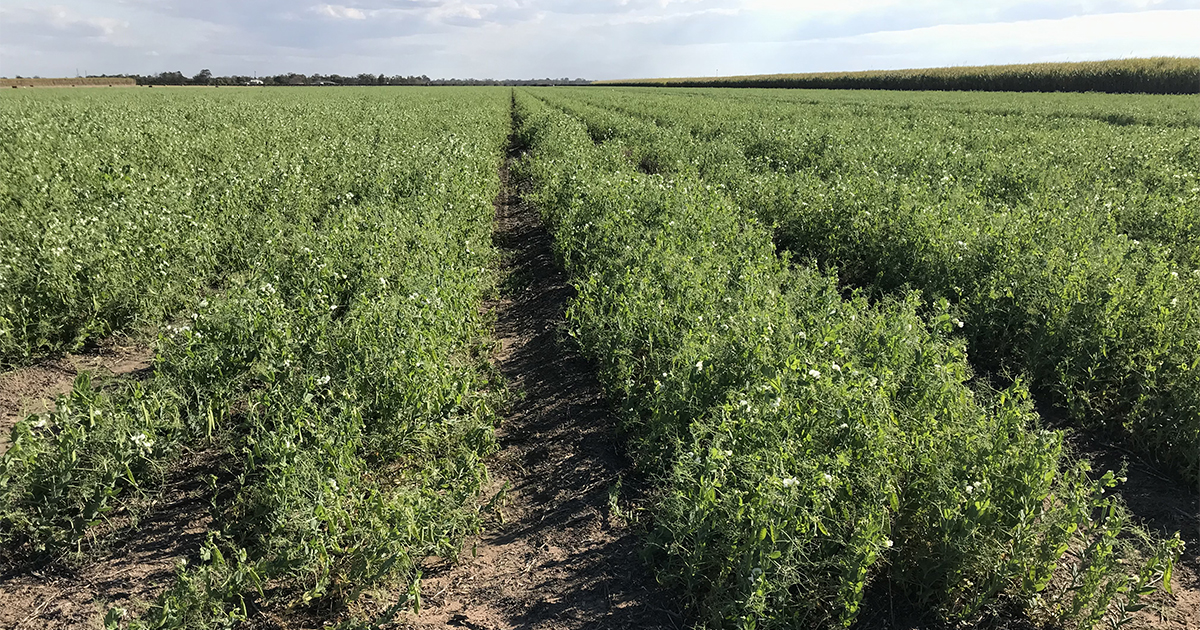
- Plants are looking healthy and are loaded with pods.
- Pod filling is occurring quickly with many pods containing large peas already.
- A small number of pods were observed to have old heliothis entry wounds and all peas inside the pod eaten.
- Vivus Max was applied over the last week to control the heliothis, protecting other pods from being damaged.
- An irrigation will be required early in the coming week as the soil is becoming dry and no rainfall events are on the horizon.
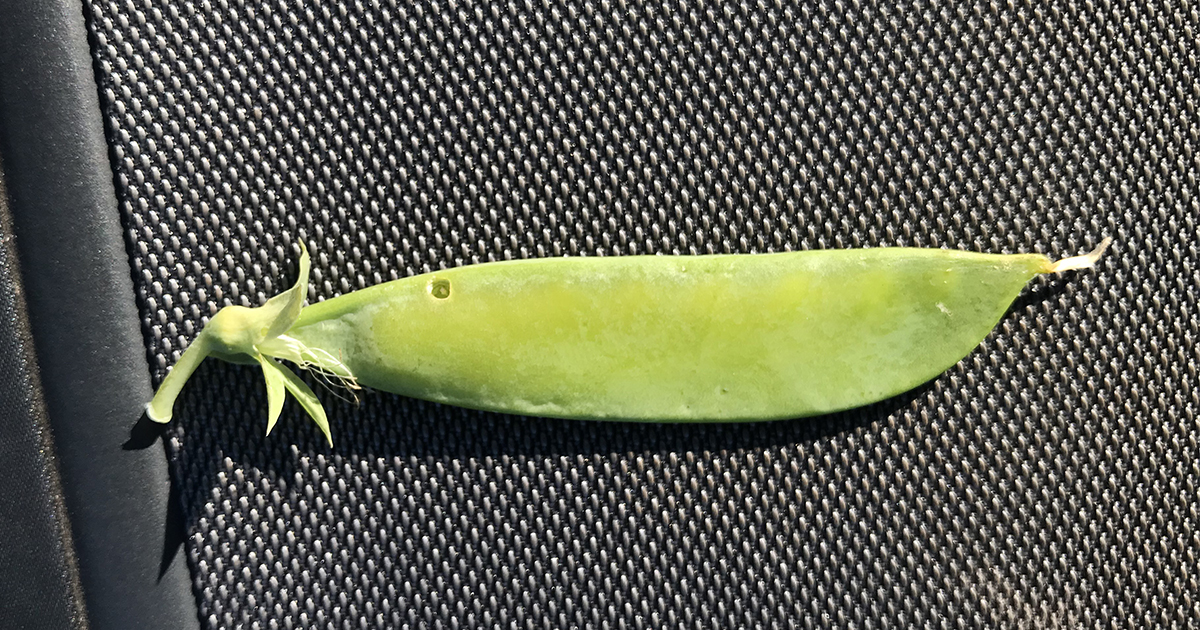 Small entry wound.
Small entry wound.
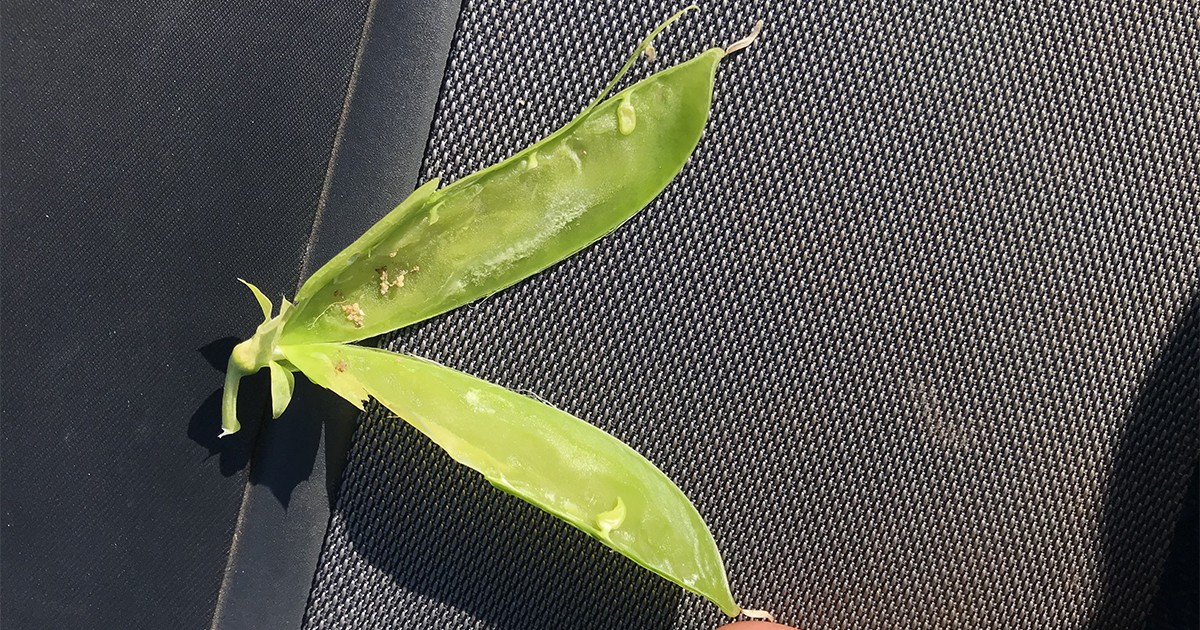 Resultant damage.
Resultant damage.
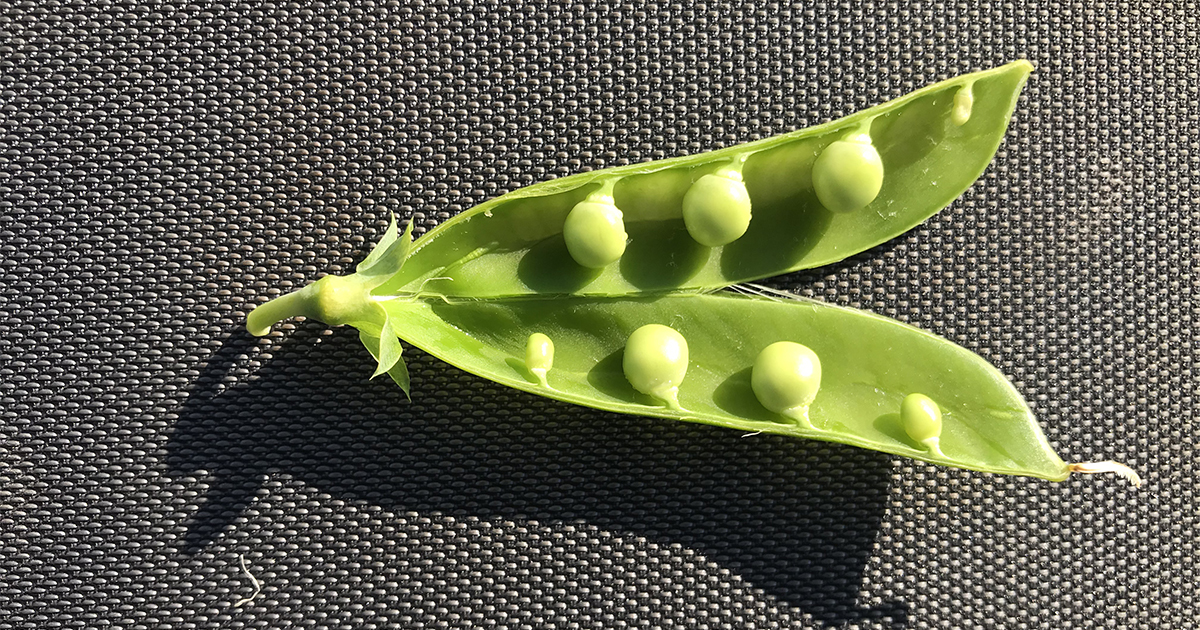 Undamaged pod.
Undamaged pod.
Week 14
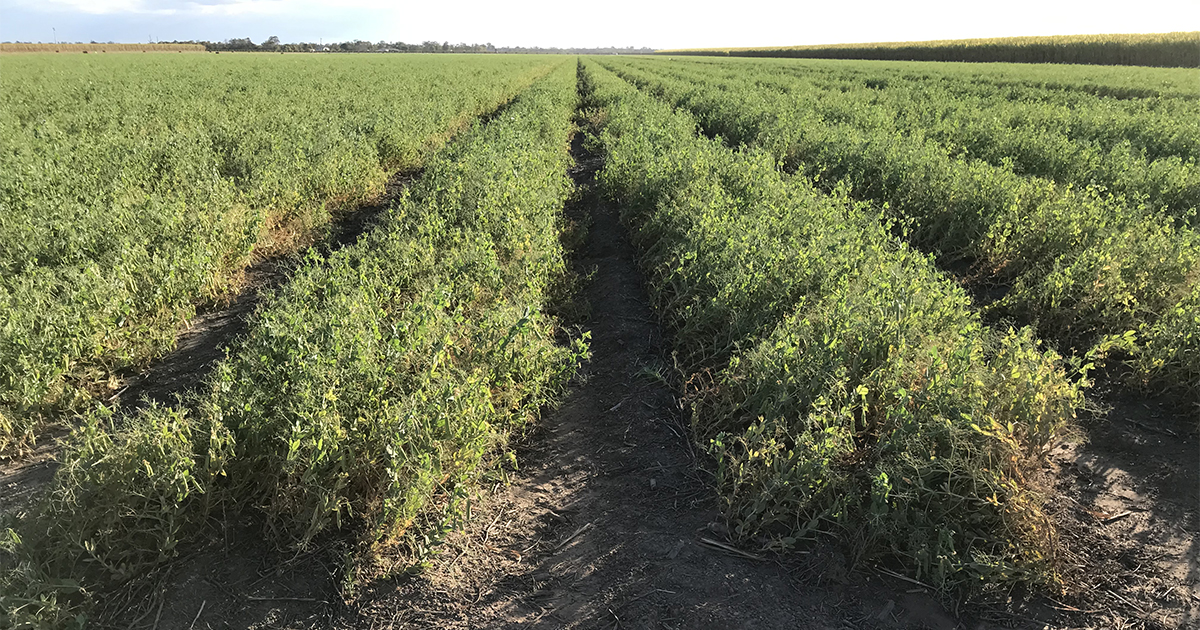
Management notes:
- Pods are still developing, and a few flowers are still opening.
- No further irrigations have been made. Hopefully we receive a shower in the coming day or so, however they are not likely to be irrigated again before harvest.
- Harvest will be in approximately 2 weeks depending on weather conditions and pod maturity.
- Reglone herbicide will be used to desiccate the crop so that harvesting can take place.
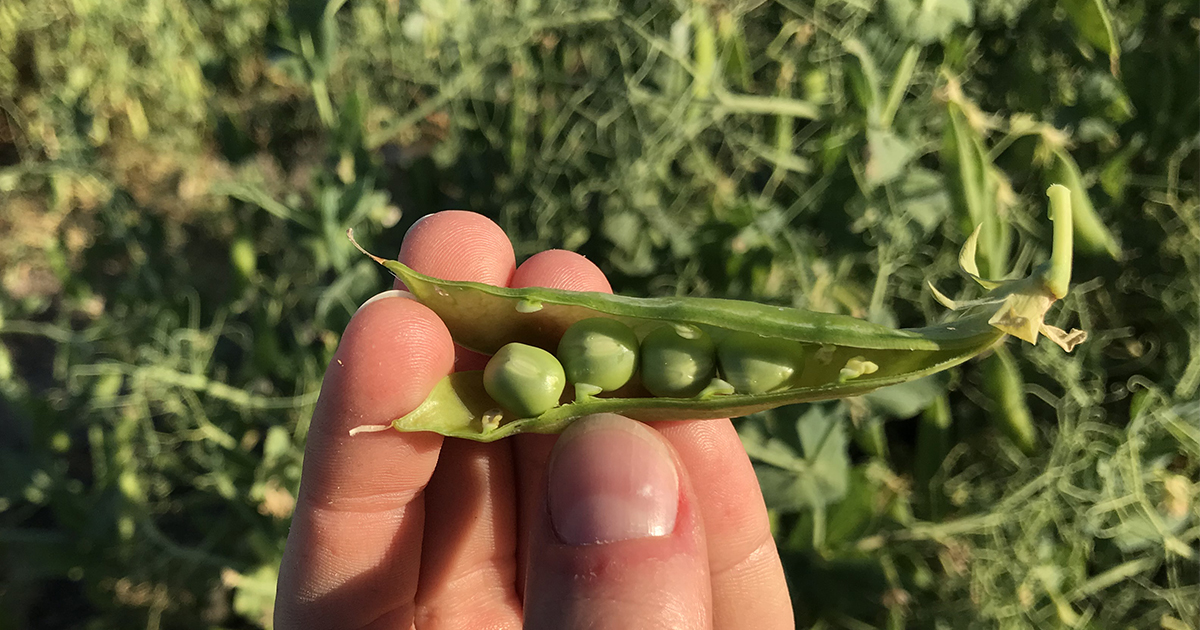 Like peas in a pod! Crop is maturing and likely to be ready for harvest within a few weeks.
Like peas in a pod! Crop is maturing and likely to be ready for harvest within a few weeks.
Week 16
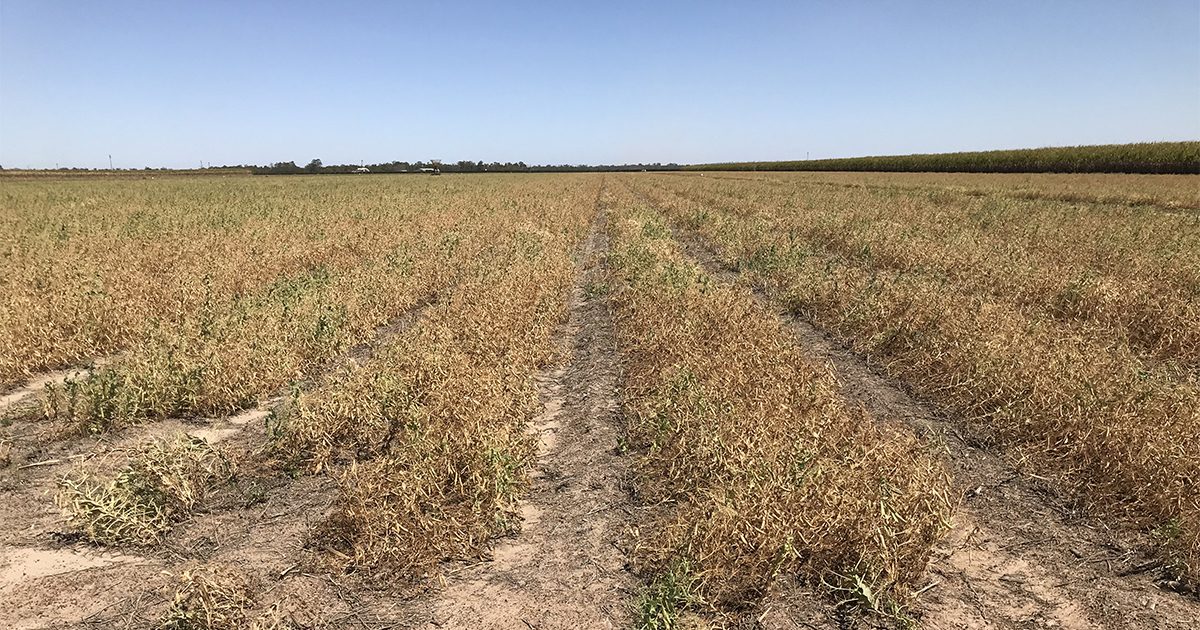
- The crop is ready to harvest and will be desiccated in the next day or two with diquat (Reglone). N.B. Field peas destined for the sprouting market or for seed should not be desiccated.
- For field peas there is no withholding period between application of diquat and harvest provided the label instructions are followed. Harvest is likely this weekend.
- Field peas are ready to desiccate when the lower three quarters of pods along the stem are brown, the shells are thin and leathery and the seeds are firm, rubbery, and split rather than squash when squeezed. Field pea pods mature from the lowest flowering node upwards. Many plants at this stage may still have green tips. Desiccate when seed moisture drops to around 30%.
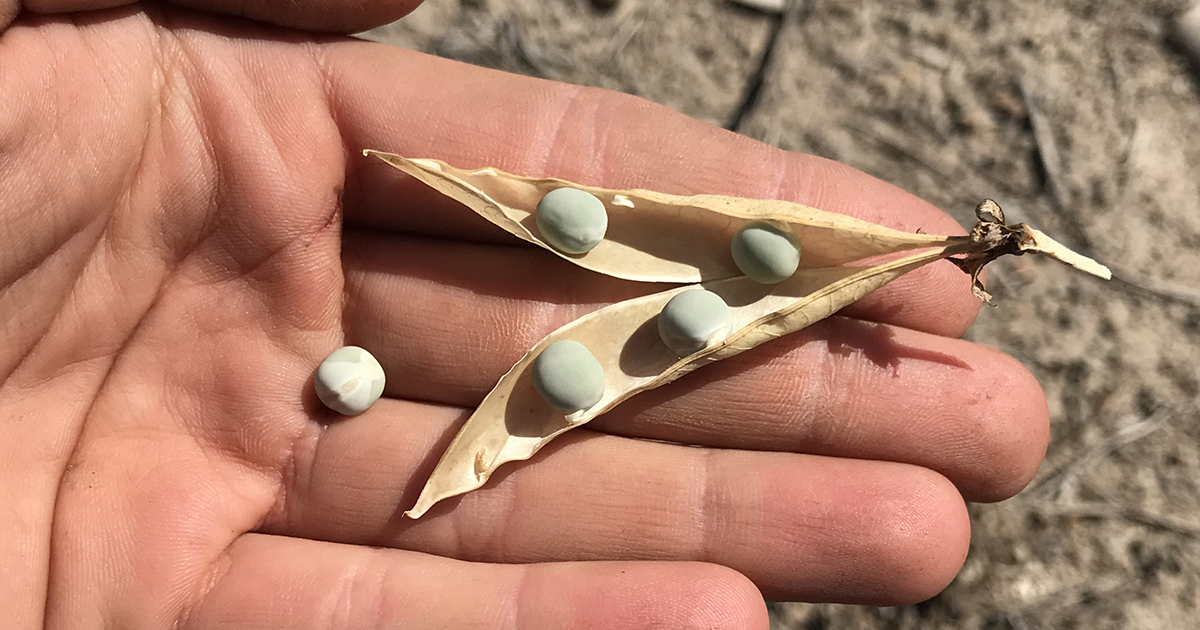 Field peas are ready to desiccate when the lower three quarters of pods along the stem are brown, the shells are thin and leathery and the seeds are firm, rubbery, and split rather than squash when squeezed.
Field peas are ready to desiccate when the lower three quarters of pods along the stem are brown, the shells are thin and leathery and the seeds are firm, rubbery, and split rather than squash when squeezed.
Week 18
- Harvest is underway.
- Grain quality is good and like everything else the peas are very dry!
- After harvest Tony plans to pre-irrigate the block then do a zonal tillage operation before planting cane to complete the cropping cycle for this block: cane – soybean – field pea – cane.
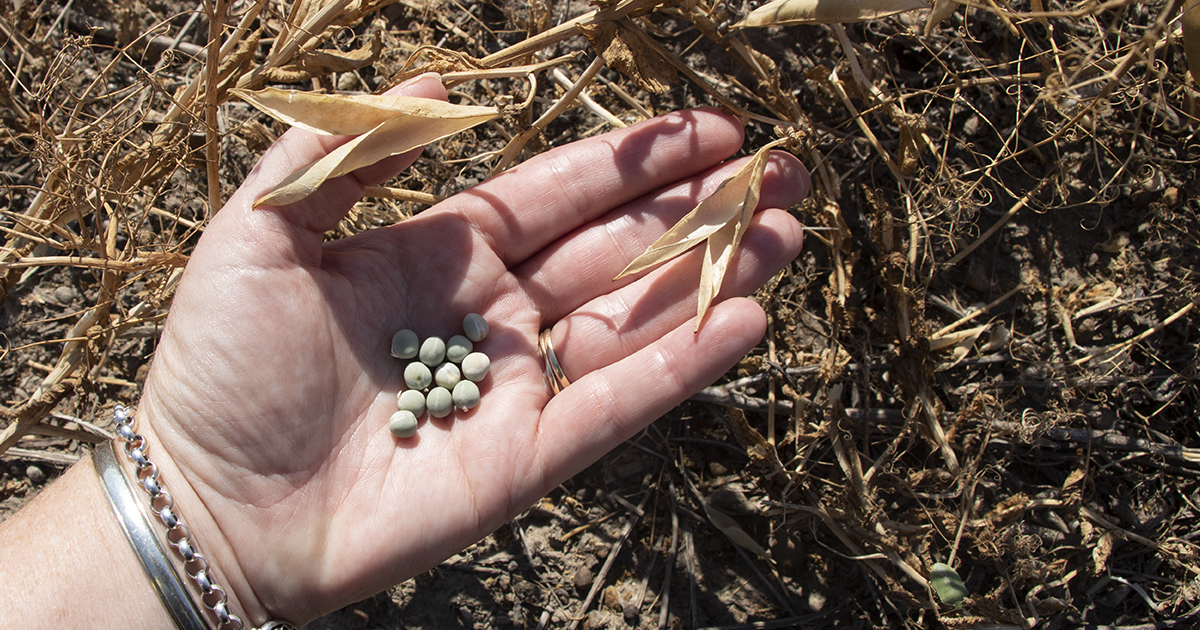 Good quality grain with very little evidence of insect damage.
Good quality grain with very little evidence of insect damage.
Read Pulse Check blog articles | Pulse Check Coastal facebook | Subscribe to the monthly newsletter


